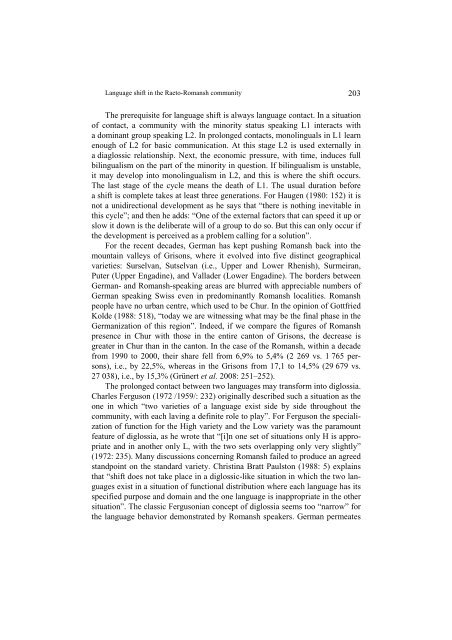s - Wyższa SzkoÅa Filologiczna we WrocÅawiu
s - Wyższa SzkoÅa Filologiczna we WrocÅawiu
s - Wyższa SzkoÅa Filologiczna we WrocÅawiu
Create successful ePaper yourself
Turn your PDF publications into a flip-book with our unique Google optimized e-Paper software.
Language shift in the Raeto-Romansh community 203<br />
The prerequisite for language shift is always language contact. In a situation<br />
of contact, a community with the minority status speaking L1 interacts with<br />
a dominant group speaking L2. In prolonged contacts, monolinguals in L1 learn<br />
enough of L2 for basic communication. At this stage L2 is used externally in<br />
a diaglossic relationship. Next, the economic pressure, with time, induces full<br />
bilingualism on the part of the minority in question. If bilingualism is unstable,<br />
it may develop into monolingualism in L2, and this is where the shift occurs.<br />
The last stage of the cycle means the death of L1. The usual duration before<br />
a shift is complete takes at least three generations. For Haugen (1980: 152) it is<br />
not a unidirectional development as he says that “there is nothing inevitable in<br />
this cycle”; and then he adds: “One of the external factors that can speed it up or<br />
slow it down is the deliberate will of a group to do so. But this can only occur if<br />
the development is perceived as a problem calling for a solution”.<br />
For the recent decades, German has kept pushing Romansh back into the<br />
mountain valleys of Grisons, where it evolved into five distinct geographical<br />
varieties: Surselvan, Sutselvan (i.e., Upper and Lo<strong>we</strong>r Rhenish), Surmeiran,<br />
Puter (Upper Engadine), and Vallader (Lo<strong>we</strong>r Engadine). The borders bet<strong>we</strong>en<br />
German- and Romansh-speaking areas are blurred with appreciable numbers of<br />
German speaking Swiss even in predominantly Romansh localities. Romansh<br />
people have no urban centre, which used to be Chur. In the opinion of Gottfried<br />
Kolde (1988: 518), “today <strong>we</strong> are witnessing what may be the final phase in the<br />
Germanization of this region”. Indeed, if <strong>we</strong> compare the figures of Romansh<br />
presence in Chur with those in the entire canton of Grisons, the decrease is<br />
greater in Chur than in the canton. In the case of the Romansh, within a decade<br />
from 1990 to 2000, their share fell from 6,9% to 5,4% (2 269 vs. 1 765 persons),<br />
i.e., by 22,5%, whereas in the Grisons from 17,1 to 14,5% (29 679 vs.<br />
27 038), i.e., by 15,3% (Grünert et al. 2008: 251–252).<br />
The prolonged contact bet<strong>we</strong>en two languages may transform into diglossia.<br />
Charles Ferguson (1972 /1959/: 232) originally described such a situation as the<br />
one in which “two varieties of a language exist side by side throughout the<br />
community, with each laving a definite role to play”. For Ferguson the specialization<br />
of function for the High variety and the Low variety was the paramount<br />
feature of diglossia, as he wrote that “[i]n one set of situations only H is appropriate<br />
and in another only L, with the two sets overlapping only very slightly”<br />
(1972: 235). Many discussions concerning Romansh failed to produce an agreed<br />
standpoint on the standard variety. Christina Bratt Paulston (1988: 5) explains<br />
that “shift does not take place in a diglossic-like situation in which the two languages<br />
exist in a situation of functional distribution where each language has its<br />
specified purpose and domain and the one language is inappropriate in the other<br />
situation”. The classic Fergusonian concept of diglossia seems too “narrow” for<br />
the language behavior demonstrated by Romansh speakers. German permeates
















